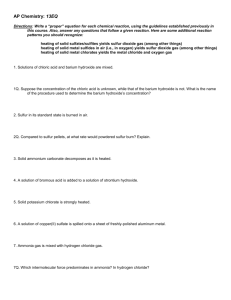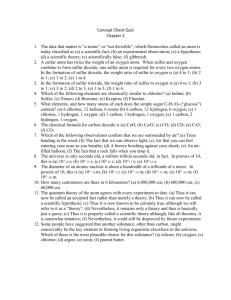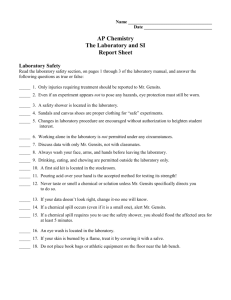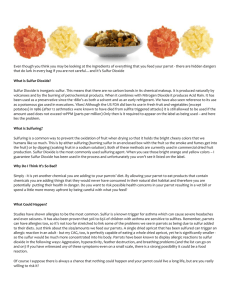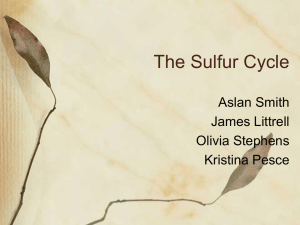Outline_bc_glect_sul..
advertisement
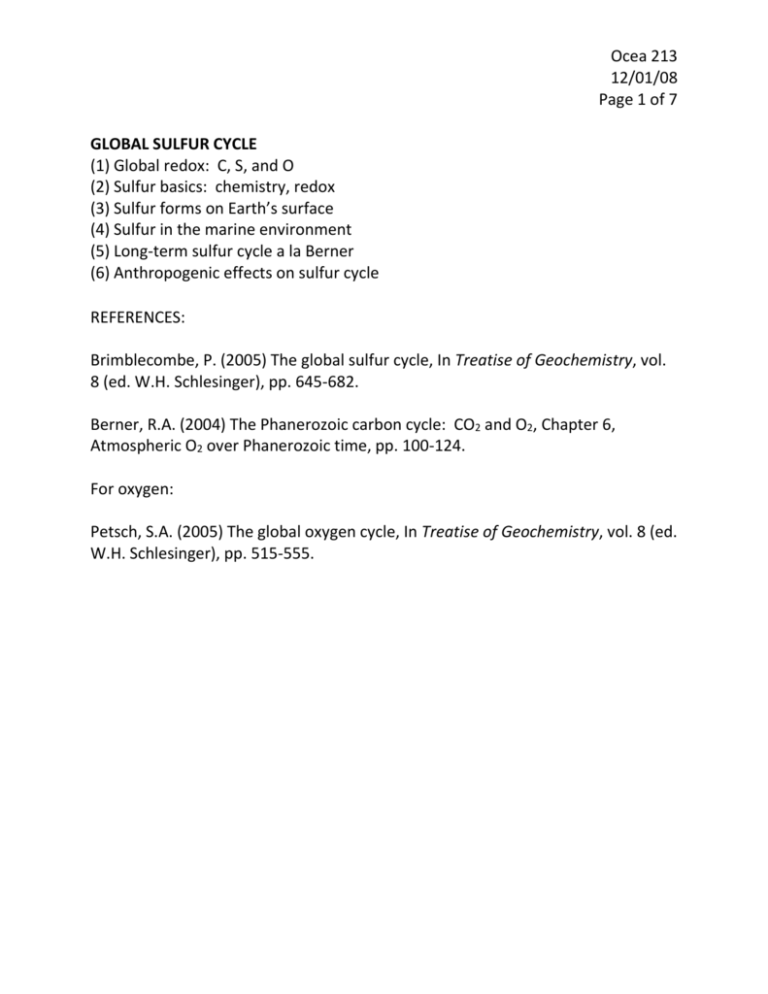
Ocea 213 12/01/08 Page 1 of 7 GLOBAL SULFUR CYCLE (1) Global redox: C, S, and O (2) Sulfur basics: chemistry, redox (3) Sulfur forms on Earth’s surface (4) Sulfur in the marine environment (5) Long-term sulfur cycle a la Berner (6) Anthropogenic effects on sulfur cycle REFERENCES: Brimblecombe, P. (2005) The global sulfur cycle, In Treatise of Geochemistry, vol. 8 (ed. W.H. Schlesinger), pp. 645-682. Berner, R.A. (2004) The Phanerozoic carbon cycle: CO2 and O2, Chapter 6, Atmospheric O2 over Phanerozoic time, pp. 100-124. For oxygen: Petsch, S.A. (2005) The global oxygen cycle, In Treatise of Geochemistry, vol. 8 (ed. W.H. Schlesinger), pp. 515-555. Ocea 213 12/01/08 Page 2 of 7 Brief word about global silicon cycle: continental weathering of silicate rocks, opaline silica burial, reconstitution into silicate rocks. Oceanic Si balance covered thoroughly in Marine Geology. Interesting issues about things like Si/C ratios in diatoms and iron, Si/C ratios in terrestrial plants. (1) Global redox: C, S, and O Why does sulfur matter? Tenth most abundant element in solar system, not very abundant in continental crust Highly mobile, biochemically active Sulfuric acid industrially important Forms large number of oxides and oxyanions, polymeric species Strong link to atmospheric oxygen and to carbon cycle, long-term o Sulfur important to atmospheric oxygen balance because of abundance and stochiometry o Iron less abundant, oxidation-reduction reactions don’t affect oxygen as much for given amount Anthropogenic pollutant (2) Sulfur basics Sulfur isotopes: four stable (Table 1) plus nine known radioactive isotopes (most very short half-lives) HANDOUT: Table 3, TOG Lots of different S forms (allotropes) from readiness to form S-S bonds Ocea 213 12/01/08 Page 3 of 7 REDOX STATES OF SULFUR S(-II) S(0) S(+II) S(+VI) H2S, HS- (hydrogen sulfide) S (elemental sulfur) S2O32- (thiosulfate ion) SO42- (sulfate ion) (3) Sulfur forms on Earth’s surface ELEMENTAL SULFUR Found in many places Usually from sulfate reduction Gunpowder ingredient Silicy an important source, U.S. now major source (20% of world production) Most (>90%) used in producing sulfuric acid, much in turn used in phosphate fertilizer production HANDOUT: Figure 7, TOG Ocea 213 12/01/08 Page 4 of 7 HANDOUT: from brochure, more details about sulfur production and consumption SULFIDES Pyrite (FeS2) Volcanogenic and sulfate reduction sources Other minerals, including calcopyrite (CuFeS2), galena (PbS), cinnabar (HgS) Sulfide ores with Cu, Pb, Ni, Zn, Au, Ag Four episodes of massive sulfide deposition o 2.69-2.72 Ga o 1.77-1.90 Ga o Devonian-Early Carboniferous o Cambrian-Early Ordivician EVAPORITES Deposits from seawater evaporation o Calcium sulfate as gypsum (CaSO42H2O) or anhydrite (CaSO4) o Precipitates out before halite o Temporal variability HANDOUT: Figure 6, TOG Ocea 213 12/01/08 Page 5 of 7 (4) Sulfur in the marine environment Sulfate ion one of seven major ions in seawater, one of three major anions conservative in seawater ~28 mM Early ocean, likely very different sulfate levels (Earth’s redox state) Hydrogen sulfide Throughout world ocean, at low levels o Oxidized in less than an hour Important form in anoxic regions o Water column Ocea 213 12/01/08 Page 6 of 7 E.g., Black Sea, other anoxic basins (restricted circulation, usually from sills) o Sediment: sulfate reduction produces HS 2CH2O + SO42- 2HCO3- + HS- + H+ o Pyrite formation Organosulfides Largest flux of volatile form is dimethyl sulfide (DMS) Lovelock et al. (1972) o Role in cloud condensation nuclei (5) Long-term sulfur cycle a la Berner HANDOUT: Berner, Figure 6.1 SOURCES OF SULFUR TO OCEAN: Sulfate in rivers, continental weathering o Oxidative weathering of pyrite o Dissolution of calcium sulfate minerals Reduced sulfur o volcanic, metamorphic, diagenetic reactions, then oxidized REMOVAL OF SULFUR FROM OCEAN: Sedimentary pyrite, calcium sulfate formation Also some pyrite, anhydrite in hydrothermal circulation REACTIONS with effect on atmospheric O2 15O2 + 4FeS2 + 8H2O2Fe2O3 + 8SO42- + 16H+ Oxidative weathering of pyrites on continents Net reaction for thermal breakdown of pyrite at depth + oxidation by atm. O2 of reduced sulfur 2Fe2O3 + 8SO42- + 16H+ 15O2 + 4FeS2 + 8H2O Ocea 213 12/01/08 Page 7 of 7 Could get this as sum of: Burial of photosynthetic carbon 16CO2 + 16H2O CH2O +16O2 Bacterial sulfate reduction 16CH2O + 8SO42-8H2S + 16HCO3Sedimentary pyrite formation 2Fe2O3 + 8H2S + O2 4FeS2 + 8H2O Neutralization of bicarbonate 16H+ + 16HCO3- 16CO2 + 16H2O REMAINING REACTIONS OF LONG TERM SULFUR CYCLE CaSO4 Ca2+ + SO42Ca2+ + SO42- CaSO4 Can translate these into effects on atmospheric oxygen—will do so in next lecture on global oxygen balance (6) Anthropogenic effects on sulfur cycle Sulfur released from fossil fuel burning, esp. high sulfur coal o Releases SO2 sulfur dioxide o Leads to acid rain Volatile organosulfur compounds as pollutants o Sulfur-rich waste waters and sewage sludge o Aluminum production o Tire wear Sulfate in rivers, increased by agricultural and industrial activities o Can be sulfide releases, with oxidation o Sulfur in various forms as fertilizer o Sulfur-containing pesticides Sulfate dusts, e.g., Aral Sea region
